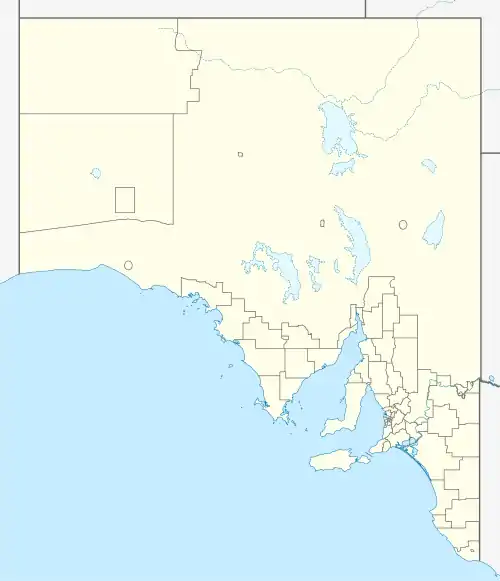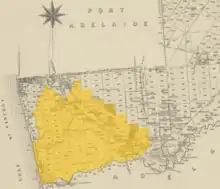District Council of Hindmarsh
The District Council of Hindmarsh was a local government area in South Australia from 1853 to 1875, seated at the inner north west Adelaide suburb of Hindmarsh.
| District Council of Hindmarsh South Australia | |||||||||||||||
|---|---|---|---|---|---|---|---|---|---|---|---|---|---|---|---|
 District Council of Hindmarsh | |||||||||||||||
| Coordinates | 34.9070°S 138.5699°E | ||||||||||||||
| Population | 3,500 (1853)[1] | ||||||||||||||
| Established | 1853 | ||||||||||||||
| Abolished | 1875 | ||||||||||||||
| Council seat | Hindmarsh | ||||||||||||||
| |||||||||||||||
At the time of its establishment the population was approximately 3,500.[1]
History

The council was proclaimed on 2 June 1853[2] on the same day as East Torrens and Onkaparinga councils.[3] Local government had only been introduced in South Australia in 1852, and only the City of Adelaide (1852) and District Council of Mitcham (12 May 1853) had been created earlier.[3][4]
The council was named, like its seat, after South Australia's first governor, John Hindmarsh, who was the first owner and subdivider of section 353, Hundred of Yatala, the triangle of land having contiguous boundaries with both the historic and present suburb of Hindmarsh, south of Port Road.[5][1] The inaugural councillors were Thomas Magarey, James Gibson, John Ready, John Packham, and Robert R. Torrens.[2]
In 1874 the Corporate Town of Hindmarsh seceded from the district council, leading to the effective end of the latter in the same form. The remainder of Hindmarsh district council moved its seat to Woodville and was renamed to be the District Council of Woodville in 1875.
Neighbouring local government
The following adjacent local government bodies co-existed with the Hindmarsh council:
- District Council of Glanville lay north west from its establishment in 1860.
- District Council of Queenstown and Alberton lay immediately north from its establishment in 1864.
- District Council of Yatala lay north east and east until it was split in two in 1868, after which time the District Council of Yatala South was Hindmarsh council's northern and north eastern neighbour.
- District Council of Prospect lay immediately east from its establishment in 1872.
- City of Adelaide northern parklands lay south east.
- District Council of West Torrens lay immediately south, across the River Torrens, from its establishment a month after Hindmarsh council.
References
- Marsden, Susan (2012). "A History of South Australian Councils to 1936" (PDF). Local Government Association of South Australia. p. 18. Retrieved 11 August 2017.
Proclaimed on 2 June 1853 as the third local government area established outside the City of Adelaide, and named after South Australia's founding Governor, Captain John Hindmarsh. [...] an area of 34 square kilometres, with a population of about 3,500.
- "Proclamations" (PDF). South Australian Government Gazette (22 ed.). Government of South Australia. 1853: 357–358. 2 June 1853. Retrieved 28 July 2017.
And I do hereby appoint Thomas Magarey, James Gibson, John Ready, John Packham, and Robert R. Torrens, to be the first Council for the said District.
- Marsden, Susan (2012). "A History of South Australian Councils to 1936" (PDF). Local Government Association of South Australia. p. 3. Retrieved 11 August 2017.
The first District Council was Mitcham, followed by East Torrens, Onkaparinga and Hindmarsh, all proclaimed in May 1853.
- "THE "GOVERNMENT GAZETTE."". Adelaide Observer. Vol. XI, no. 516. South Australia. 14 May 1853. p. 5. Retrieved 15 April 2016 – via National Library of Australia.
- "Search for 'Hindmarsh, SUB'". Property Location Browser. Government of South Australia. Retrieved 26 July 2017.
The first private town laid out in the colony. Originally a private subdivision of section 353. Governor Hindmarsh owned the land prior to the subdivision into allotments by Messers Hindmarsh and Lindsay in June 1838. Portions of the suburbs of Bowden, Brompton & Ridleyton added the–then suburb of Hindmarsh. The area of land where the suburb is located was recorded by Teichelmann & Schurmann as Karraudo-ngga and by William Williams as Kurrayundonga.